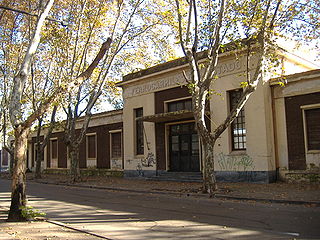
Transport in Argentina is mainly based on a complex network of routes, crossed by relatively inexpensive long-distance buses and by cargo trucks. The country also has a number of national and international airports. The importance of the long-distance train is minor today, though in the past it was widely used and is now regaining momentum after the re-nationalisation of the country's commuter and freight networks. Fluvial transport is mostly used for cargo.
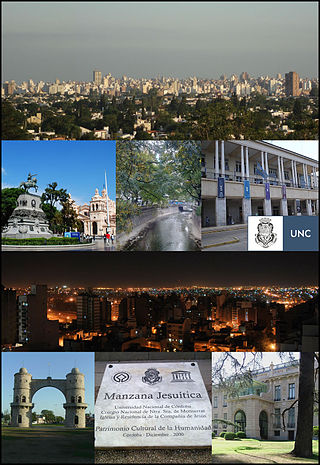
Córdoba is a city in central Argentina, in the foothills of the Sierras Chicas on the Suquía River, about 700 km (435 mi) northwest of Buenos Aires. It is the capital of Córdoba Province and the second-most populous city in Argentina after Buenos Aires, with about 1.6 million urban inhabitants according to the 2020 census. A European settlement was founded on 6 July 1573 by Jerónimo Luis de Cabrera, who named it after Córdoba, Spain. It was one of the early Spanish colonial capitals of the region of present-day Argentina. The National University of Córdoba, the oldest university of the country, was founded in 1613 by the Jesuit Order, and Córdoba has earned the nickname La Docta.
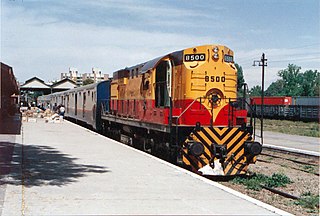
Ferrocarriles Argentinos was a state-owned company that managed the entire Argentine railway system for nearly 45 years. It was formed in 1948 when all the private railway companies were nationalised during Juan Perón's first presidential term, and transformed into the Empresa de Ferrocarriles del Estado Argentino.
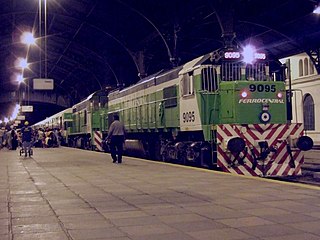
Ferrocentral was an Argentine private railway company, with a name being a portmanteau of the Spanish words for "Central Rail". It operated long-distance passenger trains from its base at Retiro station in Buenos Aires to several locations in northern Argentina, running on Ferrocarril Mitre's 5 ft 6 in Indian gauge tracks.

Trenes de Buenos Aires (TBA) (In English: Trains of Buenos Aires) was a private company that operated commuter rail services over the 5 ft 6 in (1,676 mm) broad gauge Sarmiento and Mitre lines of Buenos Aires. The company, owned by Claudio and Mario Cirigliano, also operated long-distance services on the General Mitre Railway to central-western Argentina and on the General Urquiza Railway to northern Argentina and Uruguay on the international Tren de los Pueblos Libres.

The Tranvía del Este, also known as the Puerto Madero Tramway, was a 12-block "demonstration" light rail line in the Puerto Madero neighborhood of Buenos Aires, Argentina, in operation from 2007 to 2012. It used French-built Alstom Citadis 302 trams on loan, initially from Mulhouse, France, and later from Madrid, Spain, and was operated by the rail company Ferrovías.

Sarratea is a railway station located in the north of the city of Rosario, Santa Fe, Argentina. Although no longer active, the station is currently managed by private company Nuevo Central Argentino, which operates the line for freight services.

The General Bartolomé Mitre Railway (FCGBM), named after the former Argentine president Bartolomé Mitre, is one of the six state-owned Argentine railway lines formed after President Juan Perón's nationalisation of the railway network in 1948 and one of the largest of Argentina. The six divisions, managed by Ferrocarriles Argentinos were later broken up during the process of railway privatisation beginning in 1991 during Carlos Menem's presidency.

The General Manuel Belgrano Railway (FCGMB), named after the Argentine politician and military leader Manuel Belgrano, is a 1,000 mmmetre gauge railway and the longest of the Argentine system. It was one of the six State-owned Argentine railway companies formed after President Juan Perón's nationalisation of the railway network in 1948.

The Buenos Aires and Rosario Railway (BA&R) was a British-owned railway company that built and operated a 5 ft 6 in broad gauge railway network in Argentina, where it was known as the "Ferrocarril Buenos Aires y Rosario". Originally thought as a line from Buenos Aires to Campana, it then extended to the provinces of Santa Fe, Santiago del Estero, and Tucumán.
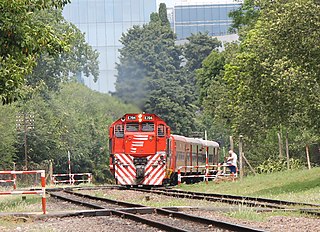
The Belgrano Norte line is a commuter rail service in Buenos Aires, Argentina run by the private company Ferrovías since 1 April 1994. This service had previously been run by the state-owned General Belgrano Railway since nationalisation of the railways in 1948. Ferrovías also formed part of the consortium Unidad de Gestión Operativa Ferroviaria de Emergencia (UGOFE) which operated other commuter rail services in Buenos Aires.

The Belgrano Sur line is an Argentine 1,000 mmmetre gauge commuter rail service in the Greater Buenos Aires area, currently operated by state-owned enterprise Trenes Argentinos. The Belgrano Sur runs over tracks and through stations built by the Franco–Belgian-owned Compañía General de Buenos Aires and British Midland companies at the beginning of the 20th century.
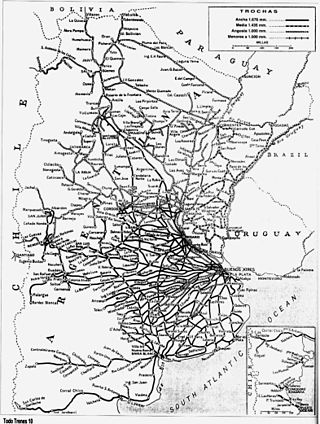
The Argentine railway network consisted of a 47,000 km (29,204 mi) network at the end of the Second World War and was, in its time, one of the most extensive and prosperous in the world. However, with the increase in highway construction, there followed a sharp decline in railway profitability, leading to the break-up in 1993 of Ferrocarriles Argentinos (FA), the state railroad corporation. During the period following privatisation, private and provincial railway companies were created and resurrected some of the major passenger routes that FA once operated.

The Córdoba Metro was a project that was supposed to, according to its proponents, serve the city of Córdoba, the second-largest city in Argentina. The metro system would have become the second metro system in Argentina, after the Buenos Aires Underground. The project was dropped after several issues.

Operadora Ferroviaria Sociedad del Estado (SOFSE), trading as Trenes Argentinos Operaciones, is an Argentine state-owned company created in 2008 to operate passenger services in Argentina. It is a subsidiary of Trenes Argentinos.

Corredores Ferroviarios was an Argentine private company that operated the Mitre and San Martín railway services in Buenos Aires Province for about one year until the Government of Argentina rescinded the agreement with the company in March 2015. Since then, the Mitre and San Martín line are operated by State-owned company Operadora Ferroviaria Sociedad del Estado (SOFSE).
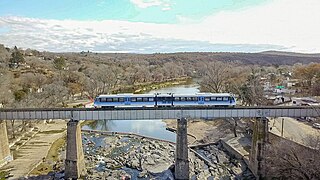
Tren de las Sierras is a 150.8 km (93.7 mi) regional rail line in Córdoba Province of Argentina. The line runs from Alta Córdoba to Cosquín, being currently operated by state-owned company Trenes Argentinos.

Santa Fe is a former railway station located in the city of Santa Fe de la Vera Cruz in Santa Fe Province, Argentina. Having been closed in March 1993 after the Government of Argentina closed all the long-distance services in Argentina, the station was reopened by the local Municipality as a convention center.

Alta Córdoba is a railway station located in the Alta Córdoba neighborhood of Córdoba in the province of the same name, Argentina. The station is terminus of the Tren de las Sierras service operated by state-owned Trenes Argentinos. Likewise, another state company, Trenes Argentinos Cargas y Logística, operates freight services there.









